PILOT



The ratification of the recent cell phone policy has been subject to frequent controversies among adolescents, particularly those here at Lindbergh High School. Students argued that the enforcement of cell phone regulations would only weaken student-teacher relationships, prove inconvenient in both social and academic settings in a variety of ways, and, as stated in a petition signed by nearly half the student body, “[hinder] our ability to learn effectively and [foster] an environment of sneakiness and increased distractions.”
But, following what came with the unfortunate string of events that occurred this early September, more nuanced discussions have emerged from this debate; students began to look further past the cell phone ban and instead garnered their attention to what it implied about the matters of personal autonomy, government infringement on individual rights, and the increasing perversion of technological advancement on modern-day society. Our first issue aims to address these conversations through the exploration of topics such as the utilization of artificial intelligence in educational institutions, the intercorrelation of social media with the polarization surrounding gun violence and, naturall y, the cell phone policy.
Despite this, Pilot does not hesitate to remind you that, above all, Lindbergh prides itself on our ability to overcome any such adversities. With this issue’s acknowledgment of the admirable efforts put into this year’s homecoming dance and celebrations of the so-far successful football season, Pilot staff is thrilled to welcome Flyer pride back to campus!
Best regards,


Mira Schoewe and Lily Donaldson Editors-in-chief

Pilot is a monthly newsmagazine published by students enrolled in the Pilot Publications class at Lindbergh High School, 5000 Lindbergh Boulevard, St. Louis Missouri, 63126. The publications office is currently locatred in Room 21.
Opinions of Pilot writers or the Editorial Board are not reflective of the opinions of the staff as a whole, the Pilot, or the administration. The Pilot welcomes responses and letters brought to Room 21.
The Pilot reserves the right to edit submissions as long as their orginal intent remains unaltered, and to refuse to print material for any reason the Editor-in-Cheif and advisor deem appropriate.
More information about our editorial policy can be found on lindberghlookup. com.


6-7 News
AI: For better or for worse?
16-18
8-12
19 Feature News
Gun violence, polarization and social media: what you need to know
Homecoming in review
HEMA showcases some surprising benefits
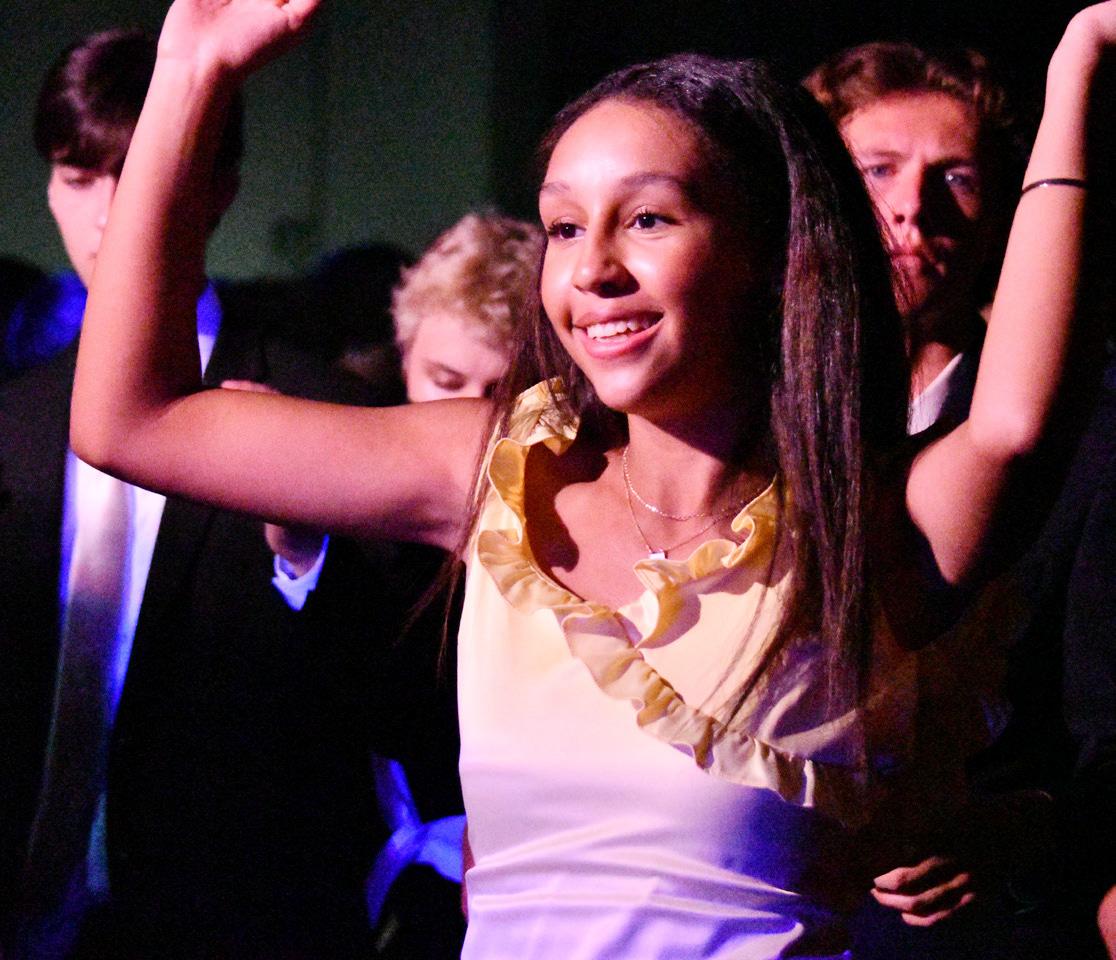
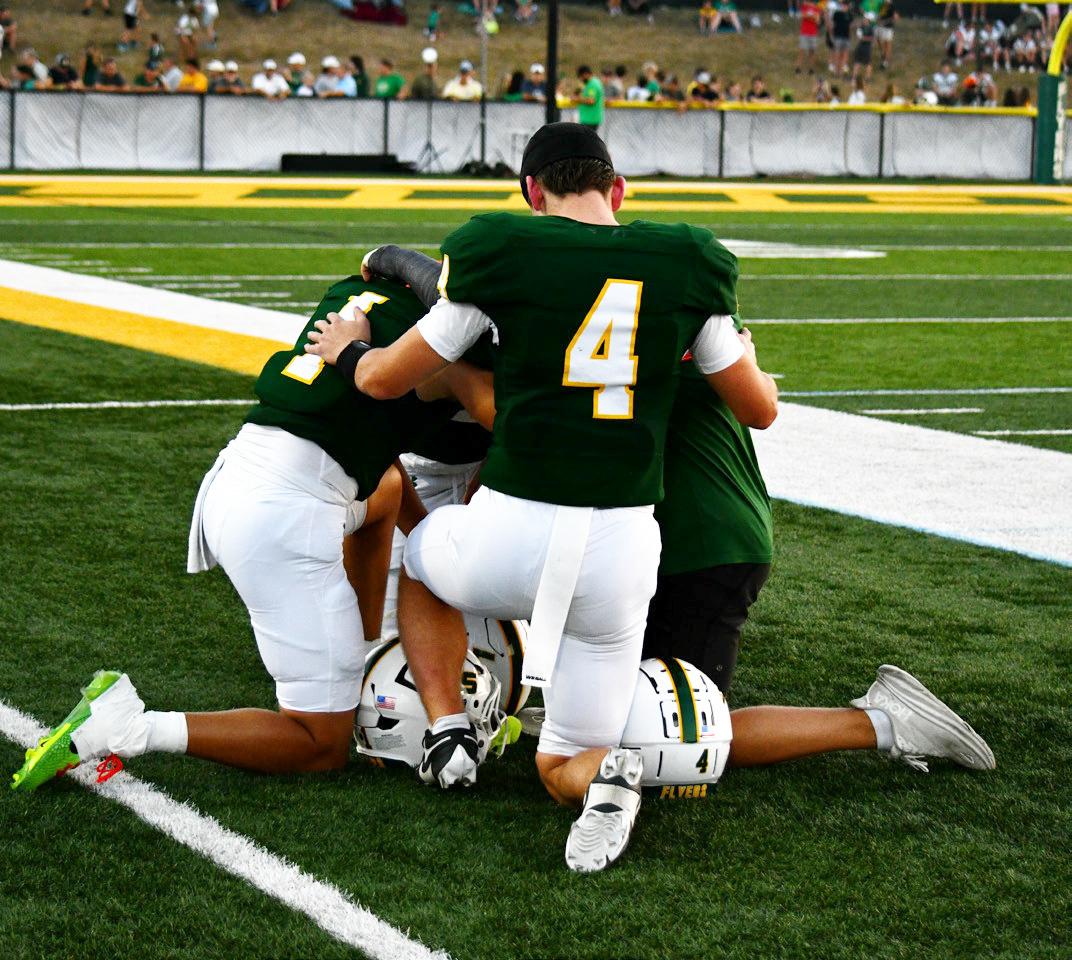
A look at Lindbergh library’s new rules
Missouri says ‘yes’ to the phone ban
Leila Thomas · Staff Writer
Leila Thomas · Staff Writer
AArtificial intelligence has done more than surpass boundaries---it has helped to create new ones. The introduction of modern artificial intelligence to the public has sparked several controversies, raising questions about how society must come to terms with these new complications. A widespread debate, and one prevalent at Lindbergh, is the debate over the use of AI in the classroom.
rtificial intelligence has done more than surpass boundaries---it has helped to create new ones. The introduction of modern artificial intelligence to the public has sparked several controversies, raising questions about how society must come to terms with these new complications. A widespread debate, and one prevalent at Lindbergh, is the debate over the use of AI in the classroom.
The popularity of artificial intelligence among educators is rapidly increasing. From assisting with class lesson plans to creating presentations, teachers have often cited the most prominent benefits of AI as its ability to lessen workload. In the 2024-2025 school year, data from The 74 News Outlet showed that 60% of teachers saved up to 6 hours a week of work by using AI. Additionally, students themselves have been using AI for homework and research assistance; because of this, numerous schools across the United States have developed mixed feelings about the potential impact of these changes on modern education. Ms. Maassen, an AP Seminar teacher at Lindbergh, shared her opinion and boundaries regarding the use of AI in the classroom.
The popularity of artificial intelligence among educators is rapidly increasing. From assisting with class lesson plans to creating presentations, teachers have often cited the most prominent benefits of AI as its ability to lessen workload. In the 2024-2025 school year, data from The 74 News Outlet showed that 60% of teachers saved up to 6 hours a week of work by using AI. Additionally, students themselves have been using AI for homework and research assistance; because of this, numerous schools across the United States have developed mixed feelings about the potential impact of these changes on modern education. Ms. Maassen, an AP Seminar teacher at Lindbergh, shared her opinion and boundaries regarding the use of AI in the classroom.
“I know in the future, it’s going to be like what the calculator is to math class. But that’s really hard to accept at the moment because it feels like cheating,” Maassen said.
“I know in the future, it’s going to be like what the calculator is to math class. But that’s really hard to accept at the moment because it feels like cheating,” Maassen said.
Despite similarities between the two, a calculator utilizes specific pre-set algorithms to perform mathematical tasks; on the contrary, AI is a dynamic platform capable of providing information across various fields, learning lessons based on past “experiences,” and, ultimately, acting as its own individual entity. In a recent interview with CNBC, however, OpenAI CEO Sam Altman noted that the phrase “a calculator for words” is his preferred description of AI’s future possibilities.
Despite similarities between the two, a calculator utilizes specific pre-set algorithms to perform mathematical tasks; on the contrary, AI is a dynamic platform capable of providing information across various fields, learning lessons based on past “experiences,” and, ultimately, acting as its own individual entity. In a recent interview with CNBC, however, OpenAI CEO Sam Altman noted that the phrase “a calculator for words” is his preferred description of AI’s future possibilities.
“AI is the most important thing to happen in a very long time,” said Altman.
“AI is the most important thing to happen in a very long time,” said Altman.
Contemporary Issues and AP Government and Politics teacher Ms. Lexie Weitzel also sees the potential of AI, believing students can use it to their advantage.
Contemporary Issues and AP Government and Politics teacher Ms. Lexie Weitzel also sees the potential of AI, believing students can use it to their advantage.
“AI is actually a good thing. It can be used, if correctly, in good ways [and] to foster creativity…I do think that there are several good uses of AI, and so I think that we should be teaching students how to use AI appropriately in the classroom,” said Weitzel.
“AI is actually a good thing. It can be used, if correctly, in good ways [and] to foster creativity…I do think that there are several good uses of AI, and so I think that we should be teaching students how to use AI appropriately in the classroom,” said Weitzel.


Researchers at the U.S. Department of Education have begun examining the potential benefits of using AI as a tool for students. One article, ‘Artificial Intelligence and the Future of Learning and Teaching,’ suggests that using AI in the classroom could make it easier for students and teachers to complete tasks, find educational resources and support, and possibly even improve their cognitive performance.
Researchers at the U.S. Department of Education have begun examining the potential benefits of using AI as a tool for students. One article, ‘Artificial Intelligence and the Future of Learning and Teaching,’ suggests that using AI in the classroom could make it easier for students and teachers to complete tasks, find educational resources and support, and possibly even improve their cognitive performance.
“Augmented intelligence is a design pattern for a humancentered partnership model of people and artificial intelligence (AI) working together to enhance cognitive performance, including learning, decision making, and new experiences,” wrote the article.
“Augmented intelligence is a design pattern for a humancentered partnership model of people and artificial intelligence (AI) working together to enhance cognitive performance, including learning, decision making, and new experiences,” wrote the article.

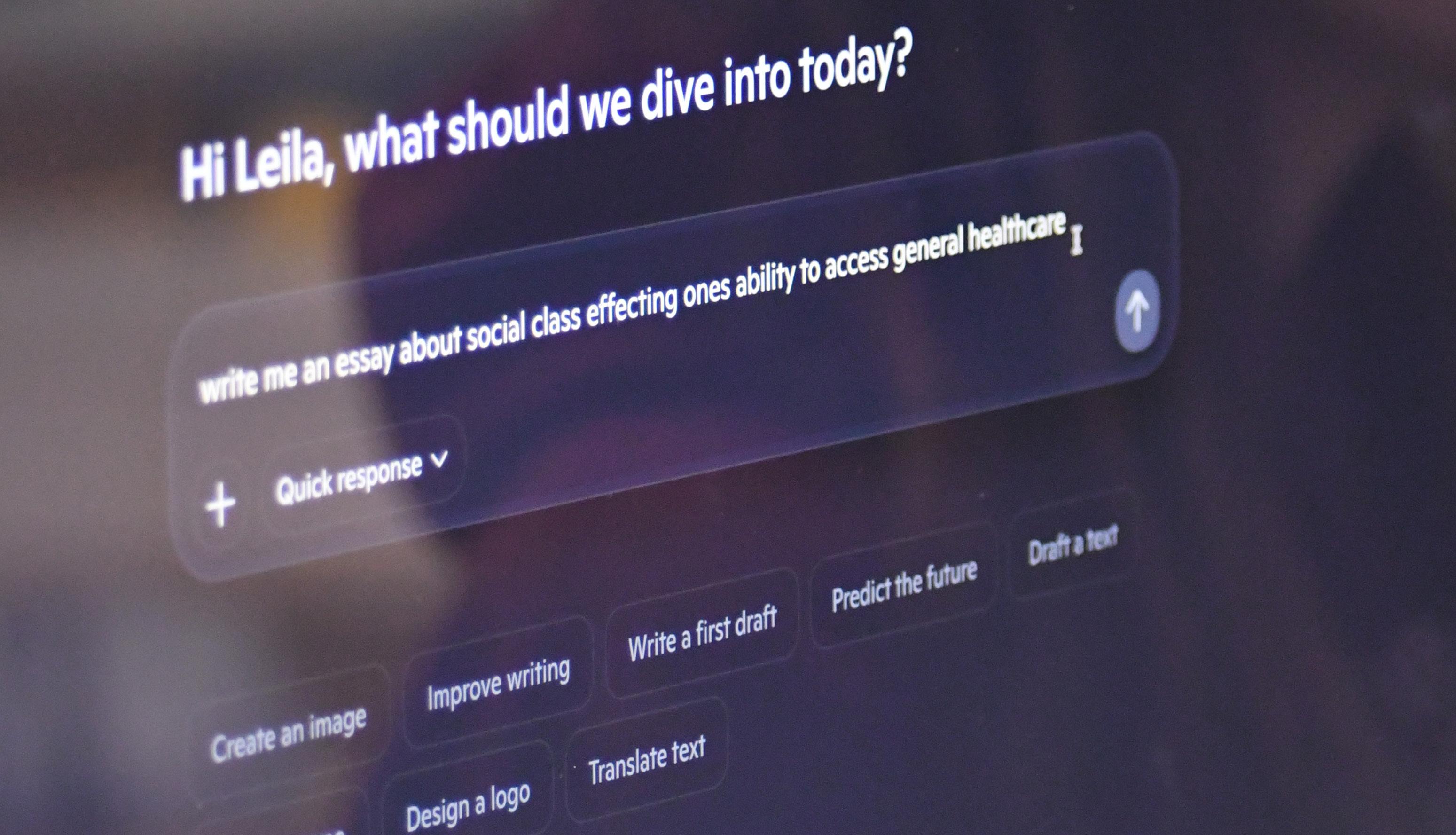



While AI can often assist with learning and provide immediate academic feedback, the article also highlights that it is equally essential to acknowledge the potential dangers and risks. Researchers at the U.S. National Center for Biotechnology Information have emphasized the impact of AI on student laziness, learning abilities, and decision-making. In addition, numerous scientists have suggested that, when not adequately regulated, AI can be detrimental to vital areas of cognitive development.
“Using electroencephalograms (EEGs) of the brain, linguistic analysis, and post-task interviews, the researchers found that using ChatGPT weakened participants’ neural connectivity, memory, and sense of ownership over their writing. While AI use allowed tasks to feel easier, the lack of effort required could, over time, dull cognition, critical thinking, and creativity,” said psychiatrist and author Marlynn Wei in a ‘Psychology Today’ article discussing recent studies from MIT on the psychological effects of artificial intelligence.
“I know in the future, it’s going to be like what the calculator is in math class.”
~ Kylee Maassen, English Educator ~
“Let’s say in school, [you] solve a problem … it requires certain functions of your brain to activate. And if you try to take the easy way out or just put [it] into AI, you’re not practicing those particular neural pathways that solve problems. So then, you don’t practice that, so then you become worse at problem-solving, and you become more dependent on the AI, and you lose that critical thinking ability,” Saunders said. “You need to activate certain parts of your brain [to] keep them active for when you’re older. And if those are the critical thinking areas, because you’ve depended so much on AI or these other tools to [think] for you, as an adult, you won’t have that capability. You’ll be limited.”
Saunders claimed that the use of AI during adolescence could have several detrimental effects when not correctly used or regulated.
Lindbergh Psychology teacher Ms. Sarah Saunders elaborated on her understanding of the relationship between cognitive function and artificial intelligence.
“The problem with a shortcut is that you have to know the long cut first. You have to have that long cut memorized … [AI] can be used as an aid, as an accessory,” said Saunders, “but it cannot replace your thinking.”
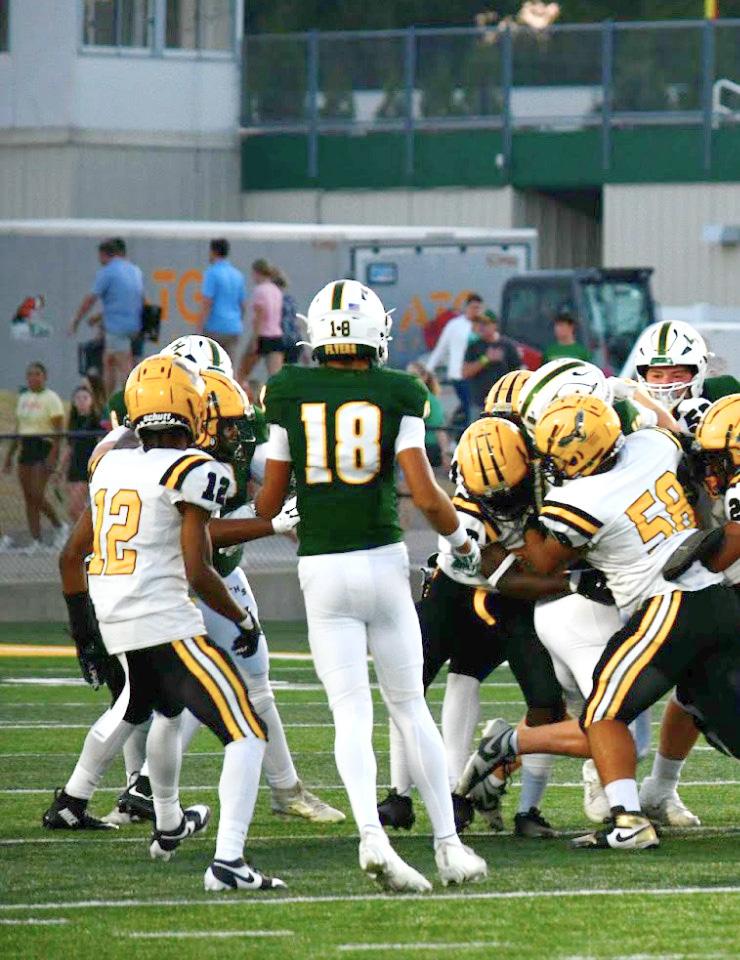
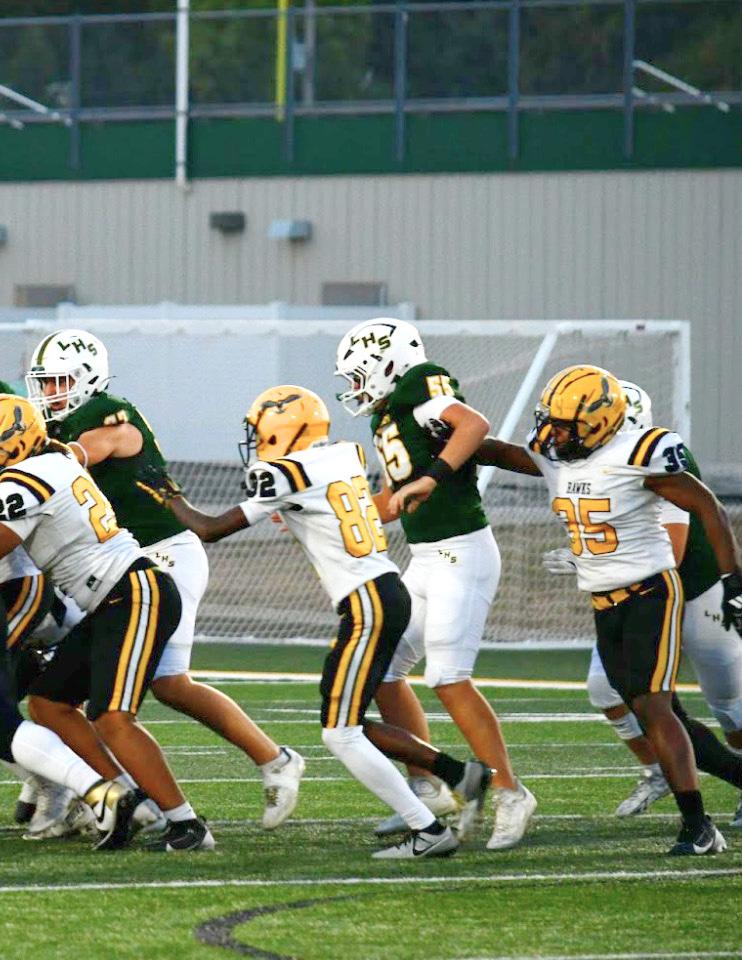


“[The] goal is playing our best when it matters how we respond after adversity. the most...What’s most important is
The best is yet to come.”
Lily Donaldson · Editor-in-chief Feature
The homecoming football game is more than just another night under the lights – it’s one of the biggest events of the school year.
Students and families crowded the stands, filling them with school colors, painted faces and the sound of the marching band as the football team prepared for one of its most anticipated matchups of the season.
For the players, homecoming is about more than just the game itself. It’s about representing their school, showing how far they’ve come and giving the student section something to cheer for. The season has had its challenges, but the team believes the progress they’ve made will continue to show on the field when it matters most. 12th grader Jackson Bailey, one of the team’s captains, said he’s already seen growth in each player over the first few weeks.
“Week by week we have eliminated more and more mistakes. We played good teams these first few weeks but I can tell that every game we’re doing so much better,” Bailey said.
That progress has come from countless hours of work, both during the in the off season. 11th grader
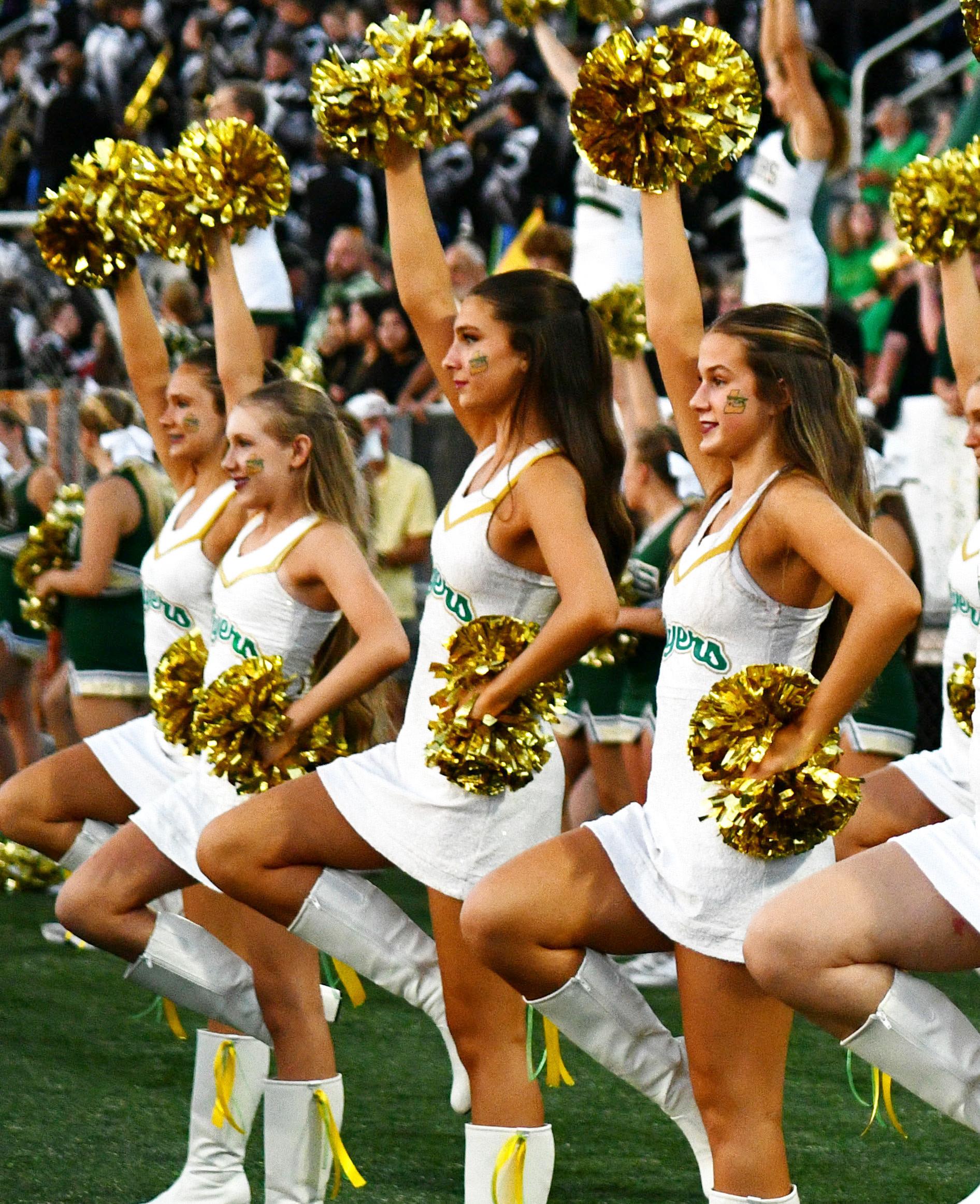
Carter Holmes felt dedication was part of what keeps him motivated as a member of the team.
“From the times spent on the field with my teammates or the hours spent training in the offseason, I love it all. The constant grind to get better, and expectations set by myself, my teammates, and my coaches to perform at the highest level makes me love the game even more.”
For football coach Benjamin McNeely, the homecoming game was also a chance to show the school community that the team is determined to always improve, no matter the early record.
“Although we came up short in our first three games, we have improved as a team. Our goal is to be playing our best when it matters the most. We have to have a sense of urgency to improve each day,” McNeely said.
McNeely further emphasized that football isn’t the only lesson being learned.
“We always hope that our players not only develop into better football players, but also into impressive young men. Adversity, whether in football or in life, is bound to happen. What’s most important is how we respond after adversity. The best is yet to come,” he said.
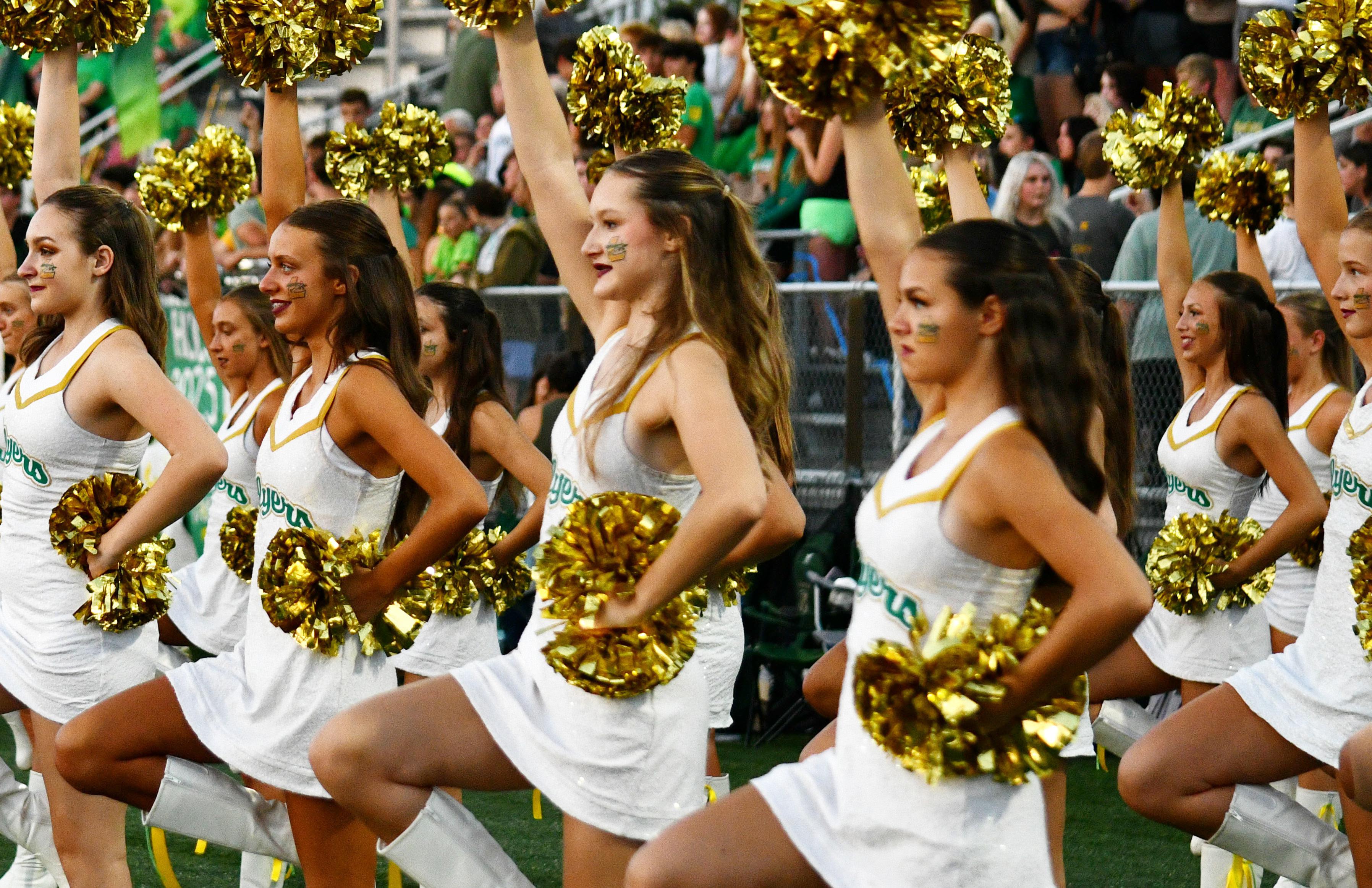




Fiona Le · Staff Writer Feature
TStudents gather on the dance floor as bright lights and music fill the gym.
he new cell phone policy, also known as Senate Bill 68, has heavily impacted Lindbergh High School students and staff.
The homecoming dance at Lindbergh High School stands out as one of the most anticipated traditions of the year. For many students, the dance is far more significant than just a night of music and decorations---it’s a celebration of school pride and a chance for the community to come together.
Planning the event takes months of preparation from the Student Council members. From picking a theme to arranging decorations, the group worked behind the scenes to make sure the evening felt extra special. Elena Adams, an 11th grader, who is the Student Council chairholder, described the excitement the event brings.
On July 9, 2025, Senate Bill 68 was signed by Missouri’s governor, Mike Kehoe. The bill banned the use of all electronic devices during school hours—including phones, headphones and personal computers—with exceptions for uses related to education and safety. Under these regulations, devices cannot be used during class, passing period or lunch. This contrasts with Lindbergh’s previous phone policy, which imposed a ban only on the use of phones strictly during instructional class time.
Mr. Andrew Little, a Lindbergh English teacher, shared his initial reservations regarding the new phone policy.
“I think the energy around the entire week of homecoming unites everyone. Homecoming brings together alumni and students to appreciate our amazing school. I think with all of the fun activities and energy this week brings, it really makes Lindbergh feel like a home,” said Adams.
That sense of unity is reflected in the details of the event. Mark Pfeiffer, the group’s sponsor, said they put effort
“When I initially heard about the phone ban, I was like, ‘this is kind of ridiculous’, just because of the fact that I thought there was a certain amount of time students should be able to use their phone
screen, like during non-instructional time [or] in the hallways or lunch,” said Little.
not only into creativity but also into handling challenges that come up during the planning process.
As months have passed since the policy was first officially implemented, however, Little now believes students have assimilated the new adjustments and demonstrated the social benefits of the ban.
“The student council members are usually very organized and hard working, but many times we have to deal with outside vendors, and I think dealing with students is not their highest priority. We look at our previous year’s reports to see if there is anything we can improve, and we also take feedback from the community last year to try to change things for the better,” Pfeffier said.
“I like it because I feel like students are [interacting more] with each other in a good way than [being] stuck on their phones too much. They’re discussing more, and they’re having to rely on that,” Little said.
Additionally, the choice of theme quickly became a talking point amongst students, many of whom were excited about the colorful decorations and festive mood it promised to bring. For some, it was the uniqueness of the theme that made it so appealing.
Mrs. Rachel Kleinberg, a psychology teacher, shared a similar opinion.
“I love the theme. Since Rio in and of itself is more related to partying, color and fun, it’s a great theme because it has some individuality and planning to it, but it’s also connected to having fun, which is something I like to do,” said Senna Paredes (11).
“I appreciate the limit in saying there are times when we are able to focus without that distraction our social skills. Because if we don’t do them in these environments, when are they happening? Like, when are we ever figuring out when to be human with each other?” Kleinberg said.
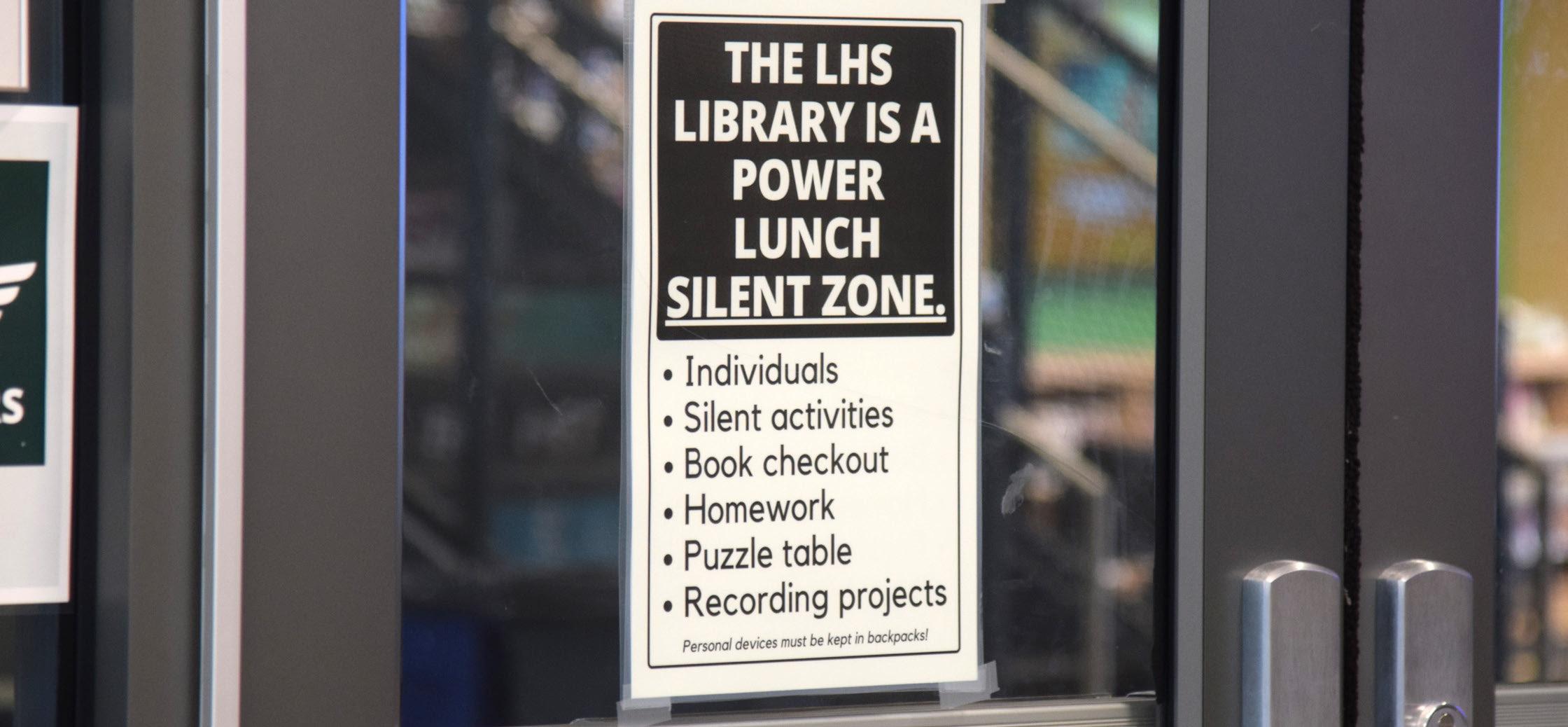
Kelly Forbes · Staff Writer Feature
tudents at Lindbergh High School are making new adjustments during Power Lunch this year, specifically with the library’s new rules. Ms. Whitehead, a librarian at Lindbergh, explained some of the new rules.
“We used to just call this, actually, where we’re sitting right now, the silent section, but now the whole library is silent during [lunch],” said Whitehead.
During last year’s Power Lunch, students at were allowed to come into the library to eat lunch, hang out with friends and talk. Students were also given the freedom to work on group projects or sit quietly and do assignments. However, all that has changed. While the library is still open during Power Lunch, the school has implemented a new set of rules regarding what students are allowed to do in the library during lunch. Ms. Whitehead believes that this has helped students find a much-needed space that wasn’t available before.
“Our students who are looking for a quieter place to be during Power Lunch, where it’s a little bit more of a port in the storm instead of part of the storm. So I think that’s kind of the purpose that it’s trying to serve. And sometimes, like people do, just like need to study real quick for a test they have later,” Whitehead said.
These new rules have made a considerable impact on LHS in comparison to previous years. In the library, students are unable to work on group projects; only individual work is allowed, and it is completed in silence. Students are still allowed to eat lunch in the library, print and check out books, but they are unable to talk, enter the library on the second floor or sit at the same table as someone else. Contrary to past years, the library is not as lenient as it once was. Ms. Whitehead felt that students were already seeing the benefits of these new regulations.
“I think it was needed. Power Lunch can be quite noisy, I think there is a certain population of students looking for a quieter place at lunch,” said Whitehead.
The library has, in fact, become more manageable during lunch; however, some students have different feelings concerning the new adjustments. Leila Thomas, a student at Lindbergh, thinks that the old rules were more beneficial to students than the new ones.
“I don’t like the new rules because it was a nice space to work on homework together with friends or projects, and it was really nice to have those separated sections of the library where one half was quiet individual work and the other side was group work,” said Thomas.
Power Lunch is one of the many useful tools for students at Lindbergh, and the library is another. While some students feel that the space was more useful when divided between individual and group work, as it was in previous years, others are enjoying this new opportunity for a completely quiet space to work during the loud, hectic lunch period. Mila Lamar, a frequent user of the Lindbergh library, claimed that the new rules are beneficial for her.
“I like the quiet when I’m doing my homework. It helps me focus, so it’s nice when I need to study during lunch and I can go to the library,” said Lamar.
Due to the new changes, students have been using the library to work instead of hanging out with friends. Despite mixed reactions to the library’s new rules, the librarians have made it clear they plan on keeping these rules in place for as long as they can to keep students productive. Mrs. Whitehead beleives it has been working better than it was before.
“I think kids are overall more productive than they have been in past years,” she said.
Newsmagazine · October 2025

Fiona Le · Staff Writer Feature
TLindbergh’s preexisting phone policy
he new cell phone policy, also known as Senate Bill 68, has heavily impacted Lindbergh High School students and staff.
On July 9, 2025, Senate Bill 68 was signed by Missouri’s governor, Mike Kehoe. The bill banned the use of all electronic devices during school hours—including phones, headphones and personal computers—with exceptions for uses related to education and safety. Under these regulations, devices cannot be used during class, passing period or lunch. This contrasts with Lindbergh’s previous phone policy, which imposed a ban only on the use of phones strictly during instructional class time.
Mr. Andrew Little, a Lindbergh English teacher, shared his initial reservations regarding the new phone policy.
“When I initially heard about the phone ban, I was like, ‘this is kind of ridiculous’, just because of the fact that I thought there was a certain amount of time students should be able to use their phone
screen, like during non-instructional time [or] in the hallways or lunch,” said Little.
As months have passed since the policy was first officially implemented, however, Little now believes students have assimilated the new adjustments and demonstrated the social benefits of the ban.
“I like it because I feel like students are [interacting more] with each other in a good way than [being] stuck on their phones too much. They’re discussing more, and they’re having to rely on that,” Little said.
Mrs. Rachel Kleinberg, a psychology teacher, shared a similar opinion.
“I appreciate the limit in saying there are times when we are able to focus without that distraction our social skills. Because if we don’t do them in these environments, when are they happening? Like, when are we ever figuring out when to be human with each other?” Kleinberg said.
Research has proven the detrimental effects of cellular device usage on cognitive performance, including emotional and social well-being and learning capabilities. Increased screen time is also linked to an increase in anxiety and depression, according to the CDC.
Despite research evidence and positive responses from Lindbergh High School students, the question remains: Is Senate Bill 68 truly a good fit, or are positive effects only temporary?
“Lindbergh is unique in the fact that the community is different from other school districts. I think you have to do what is ultimately best for your school. This is a hard rule to enforce because of how easily accessible cell phones are [and] how easily you can hide your phone or anything like that. So it’s tough, and there are times [when] I just want to teach,” said Little.
Kleinberg expressed similar frustrations.
“There are some parts about being put on the front lines of enforcing it that make me wonder. It’s all well and good for someone who isn’t going to have to be the person to enforce it. That’s very different. They are not the ones potentially getting into these negative interactions with kids about having their phone,” Kleinberg said.
The phone ban’s enforcement is additionally said to be causing pause amongst staff and students. Junior student Raquel Rojas expressed concerns that the new policy is jamming up communication during the school day.
“I thought that it was a bit much because you need to communicate. I would say that phones are used for communication, like with your parents, and also your coaches, if you play a sport,” said Rojas.
School-provided Chromebooks may allow communication through email applications and other related means; however, this may be inconvenient for students. Rojas suggested there were safety issues related to students’ inability to access their personal devices during school hours.
“I want to contact my parents, [but] then I have to wait till the bell rings to text them. If something happens, it’s annoying because I have to see it at 2:45. If an emergency happens, I can’t see it immediately,” Rojas said.
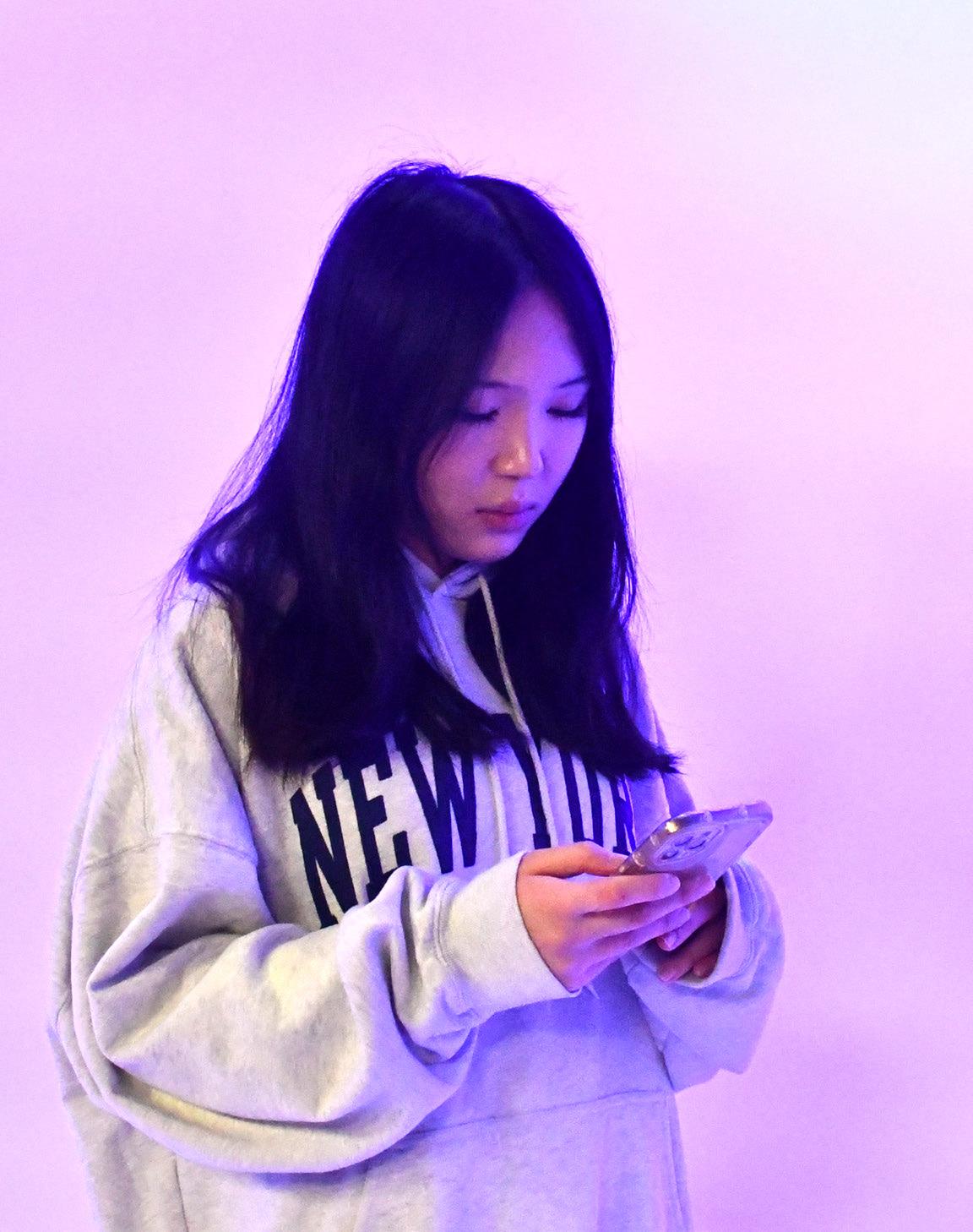
Freshman Lydia Brown is also frustrated with phone regulations for similar reasons.
“It’s hard to find your friends, especially since friends will have a different schedule from you in clubs. I’m like, ‘Hey, where are you?’ You’re going to have to [communicate] through email, and then they’re gonna have to check their email and everything, so it’s definitely difficult,” Brown said.
To ease students’ concerns, a carve-out was added to the law to address emergencies.
“Law enforcement professionals would say in emergency situations, it is typically not the best thing for everybody to be jamming the cell towers or communication lines and to be listening to the instructions of whoever is in charge of that space,” said Kleinberg.
As the new phone ban remains in place, students and staff are urged to follow enforcement procedures. Although students may frequently ask the question, “Who voted to pass the bill?” Kleinberg said the answer is clear.
“Voters voted for the people that voted on the law; we don’t have a direct democracy, we have a representative democracy,” said Kleinberg.




Mira Schoewe and Zoe Azzara · Editor-in-chief, Staff Writer
On April 20, 1999, American history was redefined. The mass shooting of Columbine brought incomparable urgency and nationwide attention to the gun violence discussion. It challenged the law, threatened traditional values and sparked an ongoing outrage. And now, nearly 30 years later, society continues to face the consequences.
“I think students feel less safe than they used to, you know? It’s really interesting to me—this has been a topic I’ve tracked my entire educational career. My first year of teaching was the year that Columbine happened, and Columbine was the first. It wasn’t the first school shooting, and it wasn’t even the first mass school shooting, but there was something about Columbine that was different, that really got this country’s attention. And it has felt like, since Columbine, these things have just been happening with greater regularity,” said Lindbergh High School principal Dr. Cochran. Since Columbine, the frequency of active shootings has increased exponentially. According to Statista, in 2023 alone, there were 350 separate incidents—the most documented in a single year. Although these events have brought more attention to the issue, the crisis remains unsolved. Recently, however, many Americans have began to wonder if the country’s lack of official gun law could be playing a key role in the situation’s increasing severity. Ms. Weitzel, Lindbergh’s Contemporary Issues and AP Government and Politics teacher, provided her insight on the situation.
“I do think that there are policies that can be put in place [without] taking away the right to bear arms. I think we should meet in the middle and compromise to keep our guns, if you want to keep your gun, but also think about how we can make the process a little more difficult if someone is struggling and gets their hands on a gun. There’s a lot that we can do to tighten up our policies so people still have the right to bear arms, but [are] still kept safe,” said Weitzel.
The regulation of firearms, or lack thereof, is perhaps among the most infamous of modern political discussions. Controversial in nature and frequently at the center of heated debate, the conversation has maintained relevance in American thought for decades. Researchers at Cambridge University have started to investigate the issue, suggesting that these conflicts have only increased in tandem with the growing popularity of cell phones and online platforms; consequently, the new generation now holds an unceasing political war in their back pockets. Dr. Cochran expressed his concerns regarding the negative influence that the online provision of these topics has on adolescents.
“Like just about anybody in this country, I have my own personal views about the causes of gun violence in the country. It’s probably multifaceted. I am generally concerned about the impact of social media in a variety of ways. I think it has impacted our political environment [negatively]…it’s driven a lot of people to extreme views that ordinarily, without social media, probably wouldn’t have some of those extreme views,” said Cochran.

able to sit down compromise the way people country for well over centuries is frustrating.”
“The fact we’re not able to sit down and compromise the way people have in this country for well over two centuries is frustrating.”
what I can say is that [social certain things. The sides of any issue,” regulation is, and may of all political preserving ones. both sides of this to stop. Nobody able to sit down and way people have two centuries is to do what we
social often partially tensions Saunders, a phenomenon to the the lack perspectives. more (it’s to this. more less of differing
I don’t know, I can’t see the future. But what I can say is that it is creating a political divide because that [social media] algorithm is only showing you certain things. The solution to that is to always look at both sides of any issue,” said Saunders.
Though the debate of gun regulation is, and may remain, controversial, American citizens of all political affiliations can agree on a common goal: preserving educational safety and protecting loved ones.
The recent Pew Research Center article, “Algorithmic Categorizations Deepen Divides,” along with numerous other studies, have suggested that social media algorithms are designed to cater to users by often withholding ideologically diverse content. This has partially contributed to recent polarization and heightened tensions surrounding the gun violence discussion. Ms. Saunders, a Lindbergh AP Psychology teacher, defines this phenomenon as “echo chambers,” a psychological concept referring to the creation of isolated ideological communities through the lack of promotion of diverse content, opinions and perspectives.
“I sincerely believe people on both sides of this issue want the same thing: they want this to stop. Nobody wants this. And the fact that we’re not able to sit down and listen to each other and compromise the way people have compromised in this country for well over two centuries is frustrating. Frustrating that we’re not able to do what we used to,” said Cochran.
“[Echo chambers] only create a larger or more intense feeling. So when you’re in a group like that (it’s called an ‘in-group bias’), your ideas and beliefs tend to become more extreme as you talk, and as you hear this. You begin to move further away from the center, the more you engage with that. Is that division going to create less of an opportunity to come together as people with differing beliefs?
I don’t know, I can’t see the future. But what I can say is that it is creating a political divide because that [social media] algorithm is only showing you certain things. The solution to that is to always look at both sides of any issue,” said Saunders.
Though the debate of gun regulation is, and may remain, controversial, American citizens of all political affiliations can agree on a common goal: preserving educational safety and protecting loved ones.
“I sincerely believe people on both sides of this issue want the same thing: they want this to stop. Nobody wants this. And the fact that we’re not able to sit down and listen to each other and compromise the way people have compromised in this country for well over two centuries is frustrating. Frustrating that we’re not able to do what we used to,” said Cochran.

Martin Corbin-Cornwell
Staff Writer Commentary
Martin Corbin-Cornwell • Staff Writer
HEMA helped me find a new form of self expression. Here’s how it can help you, too.
HEMA helped me find a new form of self expression. Here’s how it can help you, too.
TThere are a variety of hobbies and interests in our world. The one I’ve found to be most enjoyable is Historical European Martial Arts, or HEMA. While some may know it as medieval reenactment or Live-Action Roleplay (LARP), others simply refer to it as swordfighting.
here are a variety of hobbies and interests in our world. The one I’ve found to be most enjoyable is Historical European Martial Arts, or HEMA. While some may know it as medieval reenactment or Live-Action Roleplay (LARP), others simply refer to it as swordfighting.
HEMA can benefit the body in many ways. From using simple movements like a flick of the wrist to more complex actions like lunging or defending, HEMA is an efficient source of whole body exercise.
HEMA can benefit the body in many ways. From using simple movements like a flick of the wrist to more complex actions like lunging or defending, HEMA is an efficient source of whole body exercise.
HEMA also provides several mental health benefits including stress relief, enhancing on the spot thinking, developing courage further, using muscle memory to feel the thrill of the moment and enjoying yourself with people who share the same passion as you. There are multiple forms of HEMA, such as steel and heavy combat. Steel combat is most often fought with instruments such as the rapier, feder, saber and dagger. On the other hand, heavy combat uses gear such as long swords, spears, pole-arms, shields, warhammers and many other equipment geared towards the more war like aspect of medieval combat.
Boffer Fighting is where you take foam padded PVC pipes and continue on with normal HEMA rules in a safer environment. Most often, it does not require armor of any kind; the worst thing you can get injured from is lack of awareness or the terrain. It’s also more affordable, you could most likely get all the materials you need for down to around $150 if you choose the right store.
HEMA also provides several mental health benefits including stress relief, enhancing on the spot thinking, developing courage further, using muscle memory to feel the thrill of the moment and enjoying yourself with people who share the same passion as you.
There are multiple forms of HEMA, such as steel and heavy combat. Steel combat is most often fought with instruments such as the rapier, feder, saber and dagger. On the other hand, heavy combat uses gear such as long swords, spears, pole-arms, shields, warhammers and many other equipment geared towards the more war like aspect of medieval combat.
Additionally, there is another kind of medieval combat geared towards children called Boffer Fighting.
Additionally, there is another kind of medieval combat geared towards children called Boffer Fighting.
Boffer Fighting is where you take foam padded PVC pipes and continue on with normal HEMA rules in a safer environment. Most often, it does not require armor of any kind; the worst thing you can get injured from is lack of awareness or the terrain. It’s also more affordable, you could most likely get all the materials you need for down to around $150 if you choose the right store.
Now back to the HEMA side, I would like to share my personal favorite instrument to use, and one I hope to acquire soon: a fauchard, a medieval European pole-arm that consists of a blade with a slight outward curve mounted upon a six to eight foot pole. I have modified mine to have an end spike that is used to stab my opponent when my weapon is knocked back, allowing me to seamlesly transition into an attack. Additionally, I hope to acquire the shuang-ji, which is a spear head with two crescent blades on either side of it mounted to a 5-8 foot pole. Its unique shape makes it a challenging weapon to learn, but makes it efficient in combat as well.
Now back to the HEMA side, I would like to share my personal favorite instrument to use, and one I hope to acquire soon: a fauchard, a medieval European pole-arm that consists of a blade with a slight outward curve mounted upon a six to eight foot pole. I have modified mine to have an end spike that is used to stab my opponent when my weapon is knocked back, allowing me to seamlesly transition into an attack. Additionally, I hope to acquire the shuang-ji, which is a spear head with two crescent blades on either side of it mounted to a 5-8 foot pole. Its unique shape makes it a challenging weapon to learn, but makes it efficient in combat as well.
HEMA is a great source of exercise and relief. Any one can easily get into it through local competitions, online and in person groups, or starting on their own with Boffer Fighting.
HEMA is a great source of exercise and relief. Any one can easily get into it through local competitions, online and in person groups, or starting on their own with Boffer Fighting.